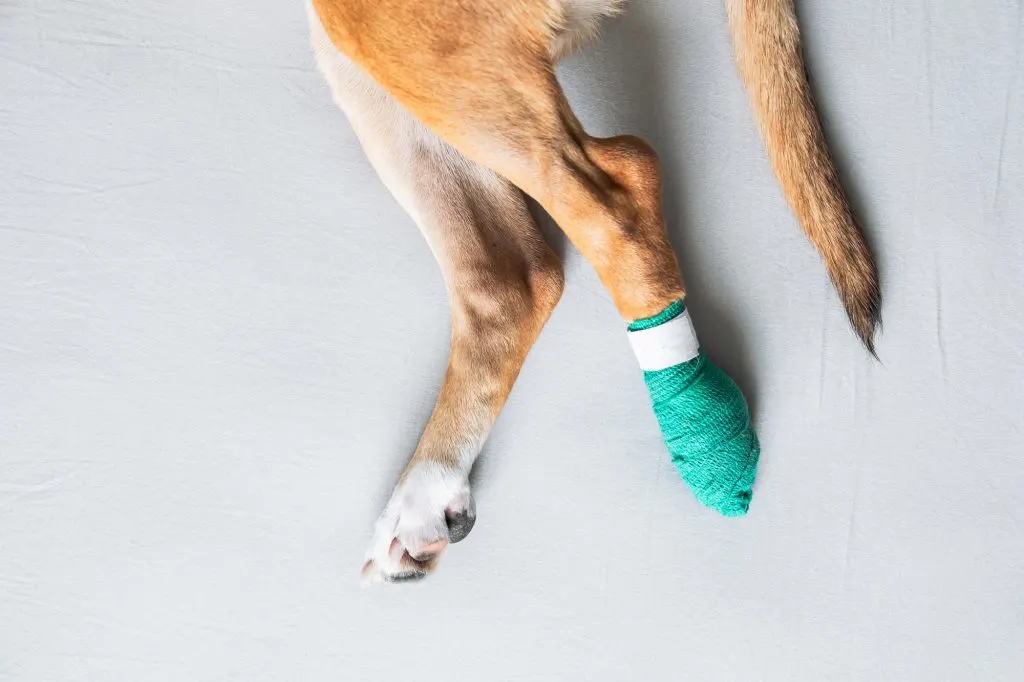Limping is a common condition that many dogs will experience in their life.
One of the biggest problems, when a dog limps, is that they can’t tell us why they’re limping so as pet parents, we get nervous.
Some types of limping in dogs can be serious whereas some can be minor.
It’s always best to check with your veterinarian but if you need a bit of insight before you get to your appointment, we’ve got you covered.
What to Do When a Dog is Limping

When dogs feel pain in the paw, elbow, shoulder or hip, they will limp to keep weight off the limb.
Some dogs may refuse to move much, while others try to stay active and suffer through pain.
Because you know your dog better than anyone else, observe carefully to determine whether your pet is in real distress.
When the limp doesn’t go away and you don’t see anything obvious, like a thorn in the paw, it’s time to call the veterinarian and get your dog some medical attention.
Observe the Limp
By observing your dog, you can sometimes make educated guesses about which limb is affected.
Sometimes the dog will make it obvious and refuse to put any weight at all on the hurting limb.
Other times, you must watch for clues.
For example, when pain is in a back leg, dogs often hold that leg more foreword than usual.
Dogs will also shift weight to the opposite side of the leg pain. Gently examine your dog for any clues, such as a laceration on the paw or a small wound on the leg. All this information can help the veterinarian narrow down the cause of the limp.
Common Causes of Limping
Limping is a dog’s way of avoiding too much weight on one if its limbs.
Just like in humans, a limp can be caused by external or internal triggers.
Here are some of the more common causes of limping in dogs:
- Paw lacerations from glass or metal fragments
- Thorns or stickers in the paw
- Overgrown or too-short nails
- Inflamed joints
- Arthritis
- Elbow or hip dysplasia, where bone fragments work into the joint
- Loose cartilage
- Tendonitis
- Torn ligaments
When to Call the Vet When Your Dog Is Limping

If you’re concerned about your dog’s limp, call the veterinarian for a consultation.
Describe the symptoms and see whether the vet suggests you bring the dog in right away or if it can wait.
Don’t feel embarrassed about calling the vet, even if your dog’s limp turns out to be no big deal.
Limping is just one symptom of several major health issues for dogs, so it’s better to be safe than sorry.
Your dog relies on you to take care of his physical needs, including getting him to a professional who can help remedy a limp.
If your pet is showing any signs of distress or you suspect your pet is seriously ill, contact your veterinarian immediately. This information is not meant to be a substitute for veterinary care.
This is a guest post written by Ryean Bishop from Bannock Animal Medical Center. BAMC is dedicated to providing compassionate care to dogs and their people. They specialize in the treatment of dogs and cats with an open door policy to anyone who wants to learn more about what we do.
Maya
Friday 15th of April 2016
About a year we noticed that our dog started to limp after a long walk out in the snow. We took her to the vet immediately and after an x-ray we figured out she had a torn ACL. We discussed the different options with our and decided to opt of surgery and go with the conservative treatment, which was hard!! It meant restricting her activity as much as possible for 8 weeks. No playing, no jumping, it broke our hearts to see her lying on her bed all day but in the end we knew it was for her benefit!
Our vet also recommended an Ortocanis dog knee brace to help stabilize her knee while the tissue repaired itself, and to keep the area warm with increased blood flow.
The combination of the two worked for us. It's been a year now and she's as active and happy as ever!
Liz Riffle
Tuesday 14th of April 2015
Is phantom lameness a real thing for giant dog breeds? How about a growing puppy? My brown Newfie has been favoring his front left for almost a week now. It previously happened if he jumped out if the car but trainer recently told me that phantom lameness was a real thing.
Richard
Thursday 13th of March 2014
Hi I have got a 13 year old lab, she has got arthritis,she is on metacam,green lipped muscles,she has got a limped on her front left foot.
humanrescuesdog
Monday 9th of September 2013
good post - my dogs have limped a couple of times in the past and it's so sad to see them like that. The first time turned out to be hip dysplasia and the second time a spit toenail.
Kimberly Gauthier
Sunday 8th of September 2013
This is a very useful post.
We learned not to ignore a limp and I'm glad that we went to the vet, because that's when we learned that two of our dogs have early onset arthritis. Then we went through a period when we were trying to get their joint dosage right. Now they limp slightly if they over do it playing, but we still monitor their activity just in case.